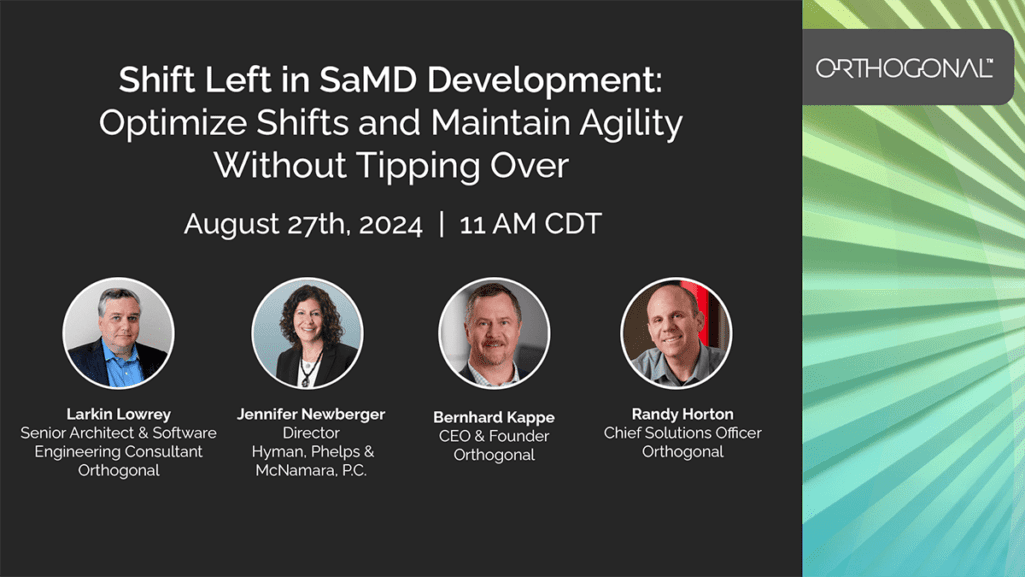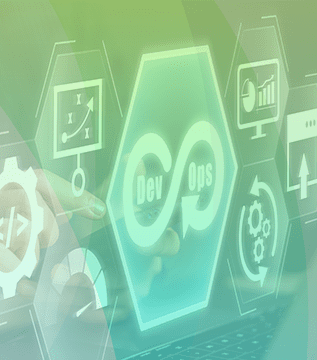
Talk
SaMD, Digital Ecosystems and the New Rules for Cybersecurity

At a recent well-respected MedTech conference, the concept of “Shift Left” was brought up in over half of the presentations. Coined in 2001 by software developer Larry Smith[1], Shift Left is the principle of moving activities such as design, testing and regulatory feedback from their traditional places later in the development life cycle to earlier stages, when misconceptions, misalignments and bugs can be more easily and cheaply fixed. It’s a powerful concept at the core of many innovations in product development, quality and software circles.
However, after hearing Shift Left discussed for the umpteenth time, we began to wonder – is there a limit to how much you can Shift Left on every aspect of medical device software design and development? At a certain point, if every activity is shifted all the way to the left, do we run the risk of a well-tuned Agile project tipping over so far that we start doing Waterfall-style planning instead of evolving in an Agile manner?
Orthogonal held a webinar on August 27, 2024 that took a look at techniques for optimizing Shift Left across an entire MedTech development organization while maintaining the fundamental flexibility of Agile. Our speakers, who bring a breadth and depth of perspective from working for different MedTech organizations, discussed how Shift Left can be applied across a variety of MedTech functions including R&D, software engineering, cybersecurity, quality and regulatory affairs, product management and corporate leadership.
1. Broadly speaking, the goal of Shift Left is to bring cross-functional teams together to uncover risks early and spur innovation. When applied to a medical device organization, Shift Left helps to validate assumptions about what will and won’t work for a given product. Traditionally, product development teams in MedTech and in virtually every industry have sought external feedback from users and stakeholders of their products at the end of the product life cycle, when it’s costly or outright impossible to make changes. By moving feedback from external teams like regulatory, UI/UX and legal, etc., to the start of the product life cycle, organizations gain an understanding of the constraints they need to work within to create a successful product.
2. Best practices for Shift Left for medical device organizations:
a. Identify the people/teams that need to participate in the medical device product development process. The following slide, made by Larkin Lowrey, outlines the 15 relevant areas of expertise in a medical device company:
b. Hold an initial all-hands-on-deck meeting with leadership from every team to understand each team’s high-level priorities.
c. Lay out a roadmap of key decision points accessible to all so everyone knows what decisions need to be made, when and by whom.
d. Create individual entries (i.e. kanban cards or user stories) for each high-level device requirement and score them based on metrics such as commercial value, clinical value, cybersecurity risk and cost benefit.
e. Prioritize questions for teams and subject matter experts (SMEs) on the areas of highest risk and/or benefit to the device. If potential risks or benefits of a device feature are unclear, that’s a signal to engage SMEs for further input.
3. When a medical device company doesn’t embrace Shift Left, devices are made under unproven assumptions about the market, user base, technology and regulatory requirements. By the time these assumptions are challenged, it’s often too late to make changes to the device, forcing companies to retrofit the product to meet market and regulatory demands. Without considering all aspects of a device upfront, companies can get trapped with sunk-costs based on fallacies about what the device needed to be, but now prevent it from being profitable.
4. SME team leaders can’t be expected to manage every detail of their team’s project, but they must keep abreast of key project developments and questions. It’s recommended that team leaders have regularly scheduled meetings with team members to review progress and to remind team members that leaders are the go-to resource for tough questions and clarifications.
Larkin Lowrey, Senior Architect & Software Engineering Consultant, Orthogonal
Larkin Lowrey stands as a distinguished leader in Software Engineering and Technology, boasting extensive experience across diverse sectors including Medical Devices, Vehicle Tracking and Fleet Management, Telecom, Industrial Controls, IoT, and e-commerce. His innovative contributions to these fields are underscored by his portfolio of 26 US patents.
In his role as the Senior Director of Software Engineering for Digital Health at Tandem Diabetes Care, Larkin spearheaded an Agile transformation that spanned multiple departments, including Software Engineering, Quality, Product Management, DevOps, Systems Engineering, and Regulatory Affairs. In the capacity of Chief Architect, he conceptualized and guided the construction of a novel, cloud-native analytics platform that now serves four continents and over a dozen regulatory jurisdictions.
Larkin is an alumnus of the University of California, San Diego, where he graduated with a degree in Cognitive Science. His studies emphasized the Philosophy of Science, Machine Learning, and Human Factors.
Jennifer Newberger, Medical Device Regulatory Expert, Hyman, Phelps & McNamara, P.C.
Jennifer Newberger is a medical device regulatory expert with over 15 years of experience across medical device, software, and digital health regulatory matters. After ten years as a regulatory attorney in the life sciences and digital health space, Jennifer joined Apple to help drive its global regulatory strategy. She played an instrumental role in obtaining Apple’s first de novo authorizations for its ECG app and irregular rhythm notification. After four years at Apple, Jennifer worked at Abbott Laboratories, providing support to the diagnostics and diabetes care business units in the US, Canada, and Latin America. Later, she joined Cognito Therapeutics as Vice President, Head of Regulatory Affairs and Compliance, later Senior VP, for two years. Jennifer has also served as a policy advisor at the U.S. Food and Drug Administration and a public health analyst at the Centers for Disease Control and Prevention.
Bernhard Kappe, CEO and Founder, Orthogonal
Bernhard Kappe is the Founder and CEO of Orthogonal. For over a decade, Bernhard has provided thought leadership and innovation in the fields of Software as a Medical Device (SaMD), Digital Therapeutics (DTx) and connected medical device systems. As a leader in the MedTech industry, Bernhard has a passion for launching successful medical device software that makes a difference for providers and patients, as well as helping companies deliver more from their innovation pipelines. He’s the author of the eBook Agile in an FDA Regulated Environment and a co-author of the AAMI Consensus Report on cloud computing for medical devices. Bernhard was the founder of the Chicago Product Management Association (ChiPMA) and the Chicago Lean Startup Challenge. He earned a Bachelor’s and Masters in Mathematics from the University of Pennsylvania, and a Bachelor’s of Science and Economics from the Wharton School of Business.
Randy Horton, Chief Solutions Officer, Orthogonal
Randy Horton is Chief Solutions Officer at Orthogonal, a software consulting firm that improves patient outcomes faster by helping MedTech firms accelerate their development pipelines for Software as a Medical Device (SaMD), digital therapeutics (DTx) and connected medical device systems. Orthogonal makes that acceleration happen by fusing modern software engineering and product management tools and techniques (e.g., Agile, Lean Startup, User-Centered Design and Systems Thinking) with the regulated focus on device safety and effectiveness that is at the heart of MedTech.
Horton serves as Co-Chair for AAMI’s Cloud Computing Working Group, as well as AAMI CR:510(2021) and the in-process Technical Information Report #115, all of which address how to safely move medical device computing functions into the cloud. He is a frequent speaker at conferences and webinars, including events hosted by AdvaMed, AAMI, HLTH, RAPS and the Human Factors and Ergonomics Society (HFES).
Related Posts

Talk
SaMD, Digital Ecosystems and the New Rules for Cybersecurity

Talk
Medical Device Manufacturers as Providers: A New and Emerging MedTech Model

Talk
Leveraging Automation to Deliver High-Quality MedTech Software

Talk
The Playbook for Running a Multi-Partner Engineering Organization